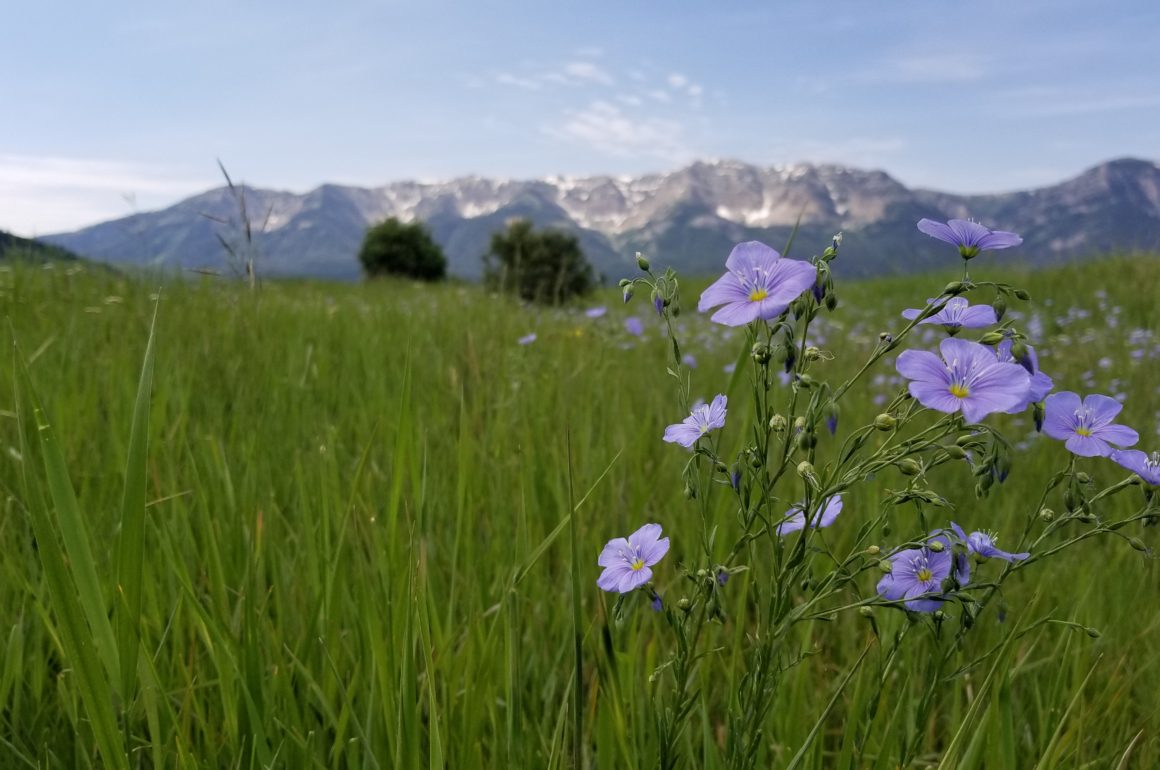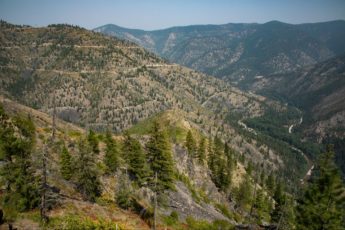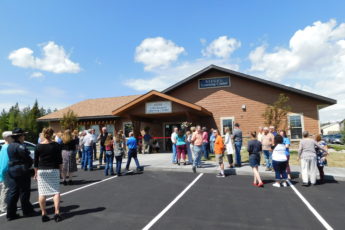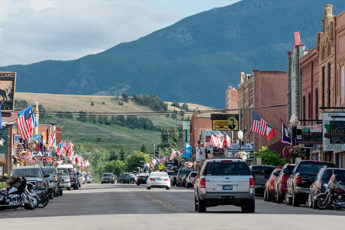
Young, old stakeholders collaborate to improve, preserve
When I walked into the Beaverhead Brewing Company in Dillon, it was easy for me to pick out Kara Maplethorpe. She sported a blue tinge on her hands from spraying weeds, a tanned face and arms, dusty blue jeans and a huge smile. I could tell she lives a life working outside in Montana’s harsh backcountry.
Maplethorpe is the executive coordinator of the Centennial Valley Association (CVA) — a stakeholder-created nonprofit that provides education and camaraderie in the agriculturally-dominant and exceptionally wild southwestern Centennial Valley.
Courtesy of the Centennial Valley Association.
It’s easy to pick up on her buzzing excitement about her work combining agriculture, wildlife management and community organization in the place that she calls home after nearly five years of work. “I could talk all day if you’d let me about CVA,” she says. “I love it so much.”
Hailing from the Chicago area, Kara found herself in the Centennial Valley as a member of the Big Sky Watershed Corps, an AmeriCorps program, part of a numerous group partnership between Montana Watershed Coordination Council, Montana Conservation Corps, Montana Watershed Coordination Council, and Soil and Water Conservation Districts of Montana. After spending a year as a Big Sky Watershed Corps member for The Nature Conservancy (TNC) in the Centennial Valley, she eventually snagged the CVA community organizer position.
Yet it’s clear that Kara did more than organize, as she became a Jack-of-All-Trades. In 2017, she moved up to executive coordinator. She has been running the show ever since while becoming a full-fledged member of the small community.
It is easy to say that the large, sparsely populated valley became her home because of the Centennial Valley Association. Working for the group allows her to meet people from all parts of the valley, divided by “North and South” as residents refer to it.
Courtesy Clare Ols- Centennial Valley Association
THE CENTENNIAL VALLEY ASSOCIATION
The Centennial Valley Association’s nonprofit mission is “To preserve traditional ranching as a way of life in the Centennial Valley, and to maintain quality open space, wildlife habitat, water quality and wildlife migration corridors as they exist today for future generations.”
As Kara says, the CVA is “the main disseminator of information” for folks in the valley in regards to land management, livestock observation, invasive weeds and more. The CVA, which is not regulated, offers aid, such as new weed-killing information.
The organization naturally found root in its home — the Centennial Valley — and the people, livestock and wildlife that inhabit it. Realizing that residents rarely talked to one another at a neighborhood get-together due to the changing ways of ranching life, stakeholders started the association to improve communication and education among far-flung landowners in the valley.
As a result, the Centennial Valley Association was formed in 2007. Structured with a board of 10 stakeholders of various occupations tied to the land and roles within the community — ranchers, outfitters, and loggers — the CVA attempts to include all who make a living on the landscape, including government agencies and other not-for-profit associations.
The CVA mission reads:
“The Centennial Valley Association creates opportunities and rallies landowners, agencies, and community members to sustain agriculture and conservation by providing a community forum to lead collaboration. CVA is the only local organization in the valley that works on projects with landowners, agencies, and non-profits as a team.”
Organizations that support the CVA include the Greater Yellowstone Coalition, The Nature Conservancy, Red Rocks National Wildlife Refuge, Defenders of Wildlife, Livestock Loss Board, Jerry Metcalf Foundation, and more. On occasion, CVA works with other non-profit groups, such as Big Hole Watershed Committee on carcass clean-up, for example.
STAFF AND WORK
Since its founding, the CVA has grown to employ a staff of six youthful leaders, including Kara, from all over the nation and Montana. All are under age 30 and hold various positions to fulfill the valley’s needs:
- Three Range Riders — Jack Cronin, Sarah Malarik, and Julia Boland oversee the interaction of livestock with wildlife, track wildlife location and patterns, and provide information about cattle conditions to ranchers. Notably, the range riders take an almost scientific approach to their work by simply monitoring livestock and predator interactions, as doctoring and other typical rider tasks do not lie within the scope of their job. However, the riders must have cattle and horse experience, as they spend a lot of time in the saddle. Cronin also serves as Wildlife Coordinator.
- Invasive Species Coordinator/Camera Trap Technician — Clare Ols oversees several projects. Nearly weed-free compared to other valleys, the CVA focuses heavily on maintaining low weed levels via stringent management, spraying and Community Spray Days. Clare maintains and organizes all wildlife encounters, especially predators. CVA has carefully placed trail cameras near carcasses or in corridors in order to meticulously catalog the data for ongoing CVA wildlife observation.
- Drought and Education Coordinator — Atalie Brown leads summer nature programs for Lima School District students every Thursday. Atalie works on a new drought outreach plan that includes several other organizations within the waters of the Upper Missouri Watershed; the data Atalie compiles will help landowners with management decisions.
Kara emphasizes how important it is to have young workers from all walks of life as part of CVA:
“They bring in new ideas, and I can really rely on them. We learn from each other, stakeholders and employees, older and younger folks.”
Atalie Brown Clare Ols Sarah Malarik Jack Cronin Kara Maplethorpe (and Merlin!)
In addition to specific field projects, CVA’s board stresses employee-facilitated, detailed and comprehensive plans for future progression of the organization, strategies and safety guidelines since human safety is of the utmost importance since valley residents live so far from medical help. The closest hospital for critical access is located about an hour or more away in Dillon — depending on a person’s starting point in the valley, proximity to Interstate 15 and, of course, the season.
By creating plans about how to safely set a camera trap on a dead carcass or determining future agendas, the organization has created protection for itself in the oncoming decades. For example, CVA can safely train and improve tactics to protect humans and observe wildlife by planning how to safely set a camera trap on a dead carcass, a dangerous task due to the likeliness of a feeding predator. Also, CVA protects itself in future years with its self-created strong procedures and institutional plans.
MEMBERSHIP
Population in the Centennial Valley varies, depending on the season. But the summer-time months show the largest numbers, which is still less than 100 people. Kara could not provide the actual number of members of CVA, but she estimates about 50-to-70 percent of the community are members, with other membership drawn from folks living outside the valley or even Montana.
Members receive impressive benefits for low dues: range riding reports, education workshops, grant assistance, invasive weed spraying aid and more. Bottom line: CVA information disseminated to the community seems to be invaluable.
For instance, ranchers who live far from their cattle’s summer pasture “can get information on how their livestock is doing, if it seems one is injured, or if a predator has been poking around,” says Kara. Communication saves a lot of time driving and monitoring — time ranchers can better spend on the ranch.
PRESERVATION OF LIFE
Again, the Centennial Valley Association’s main objective is to “preserve traditional ranching.”
Ranching certainly remains the main source of income in the valley; it is truly a beloved way of life. Ranching preserves open space for wildlife and people. It gives residents the chance to work the land and continue to live in a rural space that no other sector has filled. The best way to continue ranching is to live in a healthy landscape that is ecologically abundant and community-centered, which is why CVA works to educate its community in conservation, agriculture and camaraderie.
A ranch provides a place and a livelihood for people young and old to come together to overcome obstacles, improve the craft of land stewardship, provide wildlife management, improve range health and find happiness together.
“Everyone is trying to thrive on a shared landscape,” summarizes Kara.
— Brooke Reynolds
Special thanks to Kara Maplethorpe for spending a few hours with me at the Beaverhead Brewing Co. Not that it was difficult!
Got something to say to Prairie Populist? Send news tips, story ideas and comments to [email protected]. If you have something to submit, or an idea for a story you’d like to write for us, check out our Submission Guidelines here.



